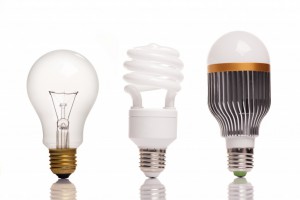We’re asked this question all the time: what is energy efficiency, and what does it mean to me? Well, simply put, energy efficiency is the act of saving energy. To elaborate, energy efficiency is the process by which a person or a business reduces energy consumption while maintaining the same or greater level of energy input. For example, an old incandescent bulb—those round bulbs you had all around your house when you were growing up—is not energy efficient compared to today’s standards. New bulbs and lamps, such as fluorescents and LEDs, generate more light and use less energy because they are more energy efficient. By changing your old lights to new ones, you’re becoming more energy efficient. Best of all, you’re saving money in the process.
Let’s get a bit more technical by comparing some numbers to add some more depth and understanding. The following chart will compare a 60w incandescent and its CFL and LED counterparts.
| LEDs | Compact Fluorescents | Incandescents | |
| Life Span | 30,000 hours | 8,000 hours | 1,300 hours |
| Watts of Electricity Used | 7.5 watts | 13-15 watts | 60 watts |
An LED’s life span is about 23 times higher and uses 8 times less energy than an incandescent. A CFL’s life span is about 6 times higher and uses over 4 times less energy than an incandescent. LEDs are the best choice for life span and energy efficiency, but they are still an emerging technology on the marketplace and can be expensive. CFLs, however, have been on the market for some time and are very affordable. Right now, if you want a good balance between energy efficiency and upfront cost, CFLs are the best option.




